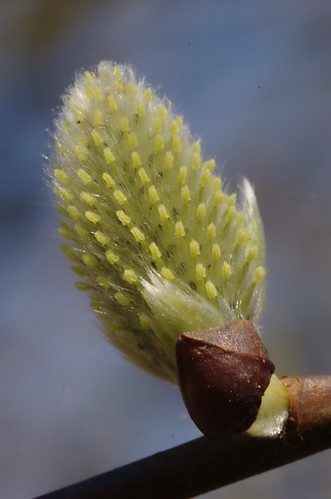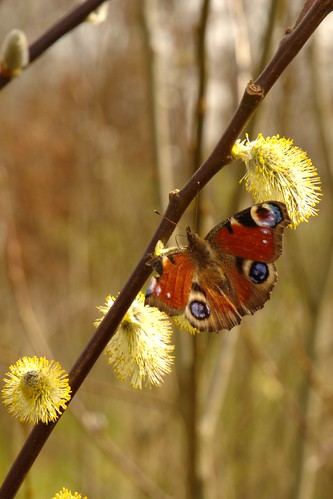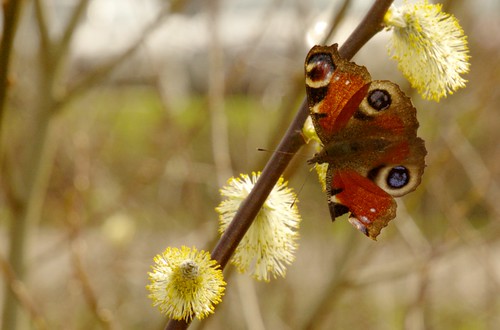(The willow in the wildlife-garden – go to English text)
De wilg in een diervriendelijke tuin

Tweehuizig, dat wil zeggen dat de mannelijke en de vrouwelijke bloemen op een verschillende plant staan.
Andere voorbeelden zijn onder andere de hulst (Ilex aquifolia) en de kiwi (Actinidia sp.), maar ook de grote brandnetel (Urtica dioica) en de heggenrank (Bryonia dioica). Trouwens, de soortnaam ‘dioica’ verwijst naar de tweehuizigheid van die soorten.
Vaak moet je de bloemen van die tweehuizige planten echt al van heel dichtbij gaan bekijken, om te kunnen zeggen of het een vrouwelijk of een mannelijk exemplaar betreft – en ik moet zeggen, dat ik echt niet zou weten of en hoe ik een mannelijke en een vrouwelijke brandnetel van elkaar zou kunnen onderscheiden.
Maar bij de boswilg, de wilg met zijn mooie zilvergrijze wilgenkatjes, kan je – als ze echt gaan bloeien – het verschil van op een behoorlijke afstand al duidelijk herkennen:
Op dat ogenblik verschijnen immers de meeldraden of de stampers, en dat verschil is op een afstand heel goed te zien:
Bij de mannelijke struiken worden de katjes als het ware bedekt met een pluizig geel dons – de soepele meeldraden met hun gele helmknoppen. De mannelijke katjes zijn dan – in mijn ogen – nog mooier dan toen het gewoon kleine bontpakketjes waren. (Een foto van een mannelijke katje zie je bij de Engelse tekst)

In tegenstelling tot wat ik vorig jaar beweerde, is de wilg niet van de wind, maar van insecten afhankelijk voor zijn bestuiving. Of je zou het ook kunnen omkeren: in het vroege voorjaar is de wilg voor heel wat insecten een belangrijke bron van stuifmeel (want dat is eiwitrijk voedsel!).
In een commentaar op mijn bericht van vorig jaar, liet katl1tje nog weten, dat er bij honingbijen een duidelijke taakverdeling bestaat, en dat één werkster nooit zowel de mannelijke (om stuifmeel = eiwitrijk voedsel te verzamelen) als de vrouwelijke bloemen (voor de nectar: suiker=energie) zal bezoeken, en dus voor de bestuiving van wilgen van weinig nut zijn. Maar behalve de honingbij die in zwermen leeft, zijn er nog een heleboel andere, solitaire bijen, en voor bijvoorbeeld de zandbijen (Andrena sp.), de zijdebijen (o.a. Colletes) en de metselbijen (Osmia sp.) is de wilg een belangrijke drachtplant, en deze solitair levende bijen zullen natuurlijk wel de twee geslachten met een ‘vruchtbaar’ bezoek vereren.
Een wilg wordt best een grote struik, waarvoor niet in elke tuin plaats is, maar als bijenplant heeft hij zeker zijn betekenis – al lijken vlinders zelfs in de mannelijke bloemen nectar te ontdekken!
The willow in the wildlife garden

Other examples of dioecous plants are holy (Ilex aquifolium), kiwi (Actinidia sp.), but also the stinging nettle (Urtica dioica) and white bryony (Bryonia dioica), that’s why their botanical name is ‘dioica’ after all…
Often you have to give the flowers of a dioecous plant a very close look, to see if it is male or female (and I have to admit that I can’t say how I should distinguish a male from a female stinging nettle!).
But for the goat willow, the ‘pussy willow’!, that difference is quite clear, from the moment the styles (in the female) and the anthers (in the male flowers) appear.
The catkins of the male flowers are than covered with a fluffy yellow cover: the stamina with their supple filaments and the yellow pollen-loaden anthers. I like the male catkins even more on this moment, than when they were only tiny little furry things.
The female catkins on the other hand, start looking duller when they reach reproductive age. The stiff, greenish-yellow pistils are protruding, and they give the catkins a courser aspect, they don’t seem to ask for caressing anymore.

Plant that have flowers without obvious petals are often pollinated by the wind, not by insects, but the willow is an exception. Although it is blooming early, it depends on insects for pollination. But the reverse seems to be true as well: in early spring, the willow is an important source of food for bees and bumble-bees.
Maybe the bees that live in swarms (like the well-known honey-bee) aren’t very important for pollination, because tasks are distributed rather strictly among those species: working-bees that have to gather pollen (found in male catkins, rich in protein), don’t gather nectar (found in female flowers, high sugar-content, energy) and vice versa. Because these working-bees will only visit one kind of shrubs, they will not have a role in polination.
(However: on the first picture of the butterfly, you see the tongue protruding, as if it is sucking nectar from the male flower, so maybe nectar can be found in both sexes.)
But apart from the honey-bee that lives in swarms, there are many solitary bees, like mining bees (Andrena sp.), mason bees (like Osmia sp.) and colletes bees (colletes sp.), and for those bees the willow is an important source of nutrition in early spring.
However, a willow is not a tiny shrub, and hence it is not suited for every type of garden. But in a somewhat larger garden, it is great for attracting wildlife.
Interessante weetjes. Ik heb nooit echt op dit verschil gelet.
Love that butterfly! I just posted on a plant that has male/female plants. I am looking closely at the blooms but can’t see a difference.
I checked out the article and was pleased to see aucubas grow over there too. I am still trying to differentiate the flowers, but have to wait until they get more mature. Then hopefully it will be obvious. Thanks for your research!
Prachtig artikel en mooie foto’s. Ik denk niet dat veel mensen beseffen hoe nuttig wilgen kan worden voor een natuurvriendelijke tuin.
David
Dat zou de eerste boom zijn die ik zou planten als ik een voldoende grote tuin zou hebben.
Anne – we have a lot of willow around here as the soil is clay, rather damp and also by a stream. I love ‘pussy willow’ – as it’s called at this time of the year over here!
My friend who keeps bees has just given me a solitary bee shelter which needs to be put up in the garden very soon.
Thanks so much for coming over to my place and telling us more about Belgian gardening from your perspective. It added so much more to the piece. I’ve had a quick look at Open Tuinen too – it looks very similar to the popular ‘yellow book’ scheme over here.
You’ve observed that garden blogging is increasing in Belgium – let’s hope it means an increasing interest in gardening too!
Beautiful pictures! Thank you for sharing.
Love pussy willows! I just found out about the male/female thing with them, since someone gave me black ones and it was interesting to see the difference once they bloomed. I want to plant them out but don’t really have a ton of space or a wet enough spot. Maybe I should pass them along to someone who does!
I had not realised that pussy willows provided so much food for wildlife. It is nice to learn something new. They are one of the few plants that I remember studying during biology classes when I was at school.
leuk om dat allemaal te lezen en dan te weten!